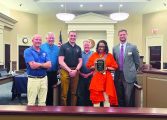Contributed by Bob and Mary Fleming Trumbull
Fluvanna native Mary Fleming Trumbull returned Monacan artifacts in the family’s possession since the 1870s to Lou Branham of the Monacan Indian Nation on May 25. The collection will be displayed at the Monacan Nation Ancestral Museum located at Bear Mountain in Amherst County.
She called it a repatriation of the Monacan relics to the Monacan Nation. The collection consists of 158 items including scrapers, grinding stones, a stone ax head, spear points, possibly some awls, and many projectile points or arrow heads.
Most of the items were found on the land of John Allan Galt, part of the original Point of Fork property. The “Fork” area has been established as the location of Rassawek, the principal town of the Monacan Indians.
The Point of Fork estate was established on inherited land in the mid-1830s by James Galt, Mary Trumbull’s great, great, grandfather. Her paternal grandmother was born there. Three generations of family members resided on the property prior to the partition of James Galt’s estate in the early 1890s. The Point of Fork home of roughly 300 acres was sold to General Lindsey Walker in the very late 1880s. The substantial majority of the roughly 3,000 acres remained with family members at the time of partition. North River Field, a part of the original Point of Fork estate, was owned until the early 1980s and served as a summer home for a great uncle and later for his son.
Some of the artifacts, all projectile points or arrow heads, were found on the Fleming family farm in Fluvanna. That farm was located on the north side of East River Road within two or three miles of the Rassawek site. A concentration of spalls (stone chips) from knapping used in the projectile point or stone tool making process, was also located on farm property by Mary’s maternal grandfather, Lee Shepherd.
Rassawek first entered the historical or written record following a 1609 voyage by Capt. John Smith and Christopher Newport up the James River to the fall line (at Richmond). A map of the location of Rassawek was created by the colonists from descriptions of the town’s location by Amoroleck, an Indian who was living in what is now the Piedmont area of Virginia. Smith and Newport did not visit Rassawek but their map established the location in the area of the confluence of two rivers, the James and the Rivanna.
The Smithsonian Institution’s Bureau of Ethnology published information regarding “Archeologic Investigations in the James and Potomac Valleys” in 1894. The document is a compilation of the various locations where archeological research had been conducted.
In regard to Fluvanna County, the article notes that “the only aboriginal remains examined in detail were those found in the vicinity of Columbia.” The article placed the location of the site in an area located on the property of Major Allan Galt, about three miles upriver from Columbia. Allan Galt did, in fact, own 1,046 acres of land deeded to him by his father, James Galt, on December 17, 1873. Allan, as a man in his mid-30s at the time, almost certainly would have been in charge of and farming the land prior to it being deeded to him.
Allan Galt’s 1,046 acres of property was described as “bounded … at a point on the James River on the upper line of the middle farm.” A plat for an additional 73 acres, received later through bequest from his father, located that property as adjacent to but upriver from Allan Galt’s much larger tract. The plat for that property notes that it was 3-1/2 miles upriver from Columbia.
The Smithsonian article indicated that following the “freshet” (flood) of 1870, “four feet of the surface had been removed, revealing not less than 40 or 50 ‘fireplaces’…. Lying among the ashes and burned earth…were many burned stones, fragments of pottery … arrowheads, great quantities of chips and broken arrows and other indications of a former Indian town… The artifacts were abundant, but nearly all were carried away by local collectors.” We know the name of at least one of those local collectors. The collection that remained with family members was housed in a wooden box with James Galt’s name on it.
The Smithsonian article continues: “Scattered between the fire beds were the graves, readily distinguished by the darker color of the earth. They were circular or nearly so, about three feet in diameter, none of them more than 18 or 20 inches deep. One contained the skeletons of a woman and child, one of a man and a woman, a few of those of two women, but most of them disclosed the remains of one individual each.”
At the time of the Smithsonian article, the researchers had not concluded that the evidence of Indian settlement found on Allan Galt’s property was Rassawek. There was some speculation that it might be Rassawek but the sentiment, probably wrongly expressed in the article, appears to have been for a location slightly down river from Columbia, actually on Elk Island. The Smithsonian researchers found evidence of human habitation on Elk Island and the Mayo Farm on the South bank of the James as well as the Allan Galt property. Perhaps there were other clusters of human habitation in the immediate area that were not located by the researchers.
Mary Trumbull was initially told about the visit of the Smithsonian researchers by her grandmother, Mary Galt Fleming, but much later as an adult, was able to locate documentation for that visit.
The Major Allan Galt property along the James River is specifically where the vast majority of the Monacan artifacts in the collection were located.
While perhaps a small gesture, the return of the Monacan artifacts to their rightful owners is much overdue. The visit to the Monacan Nation Ancestral Museum was a wonderful experience and it is highly recommended that others visit!
(Editor’s note: Mary Fleming Trumbull is a 5th generation Galt descendant. In 1964, she moved to Richmond to attend Virginia Commonwealth University. After marriage, she and husband, Bob Trumbull, lived in Richmond for several years and then relocated to the Farmville area. After retirement in 2005, the couple moved back to Fluvanna.)




